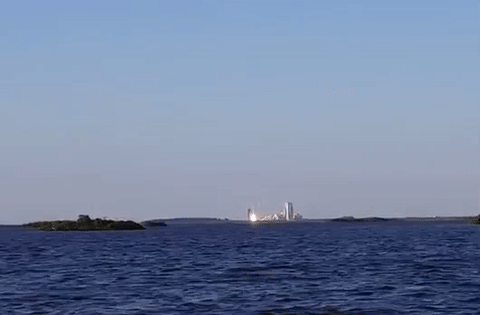


This launch went so smoothly, engineers were competing to perform their stages more nominally.
After more than a decade of development and weeks in excessively pristine storage, OSIRIS-REx left Earth last night at 7:05 p.m., riding the pointy end of an Atlas V rocket going more than 22,000 miles per hour. It leaped off the Complex 41 launch pad right on cue, warming spectators’ faces across the Banana River.
At 8:04, the spacecraft was flying free from the rocket, with no anomalies. By 9, the mission leads entered a press conference to whoops and applause.
“Tonight is a night for celebration. We are on our way to an asteroid,” NASA Chief Scientist Ellen Stofan said in the conference, where the mood was near giddiness. “Every day at NASA we’re turning science fiction into science fact, and that’s what we did tonight.”
The spacecraft is happy and healthy, reported Rich Kuhns, program manager at Lockheed Martin Space Systems. They’d deployed both solar panels, oriented the spacecraft appropriately, and established communications. “Let’s go get the science,” Kuhns said.
OSIRIS-REx will spend the next seven years heading for Bennu, an ancient Goldilocks asteroid — not too small, not too far — made of carbonaceous materials from when the solar system formed.
The first U.S. mission to bring back a piece of an asteroid joins the likes of Viking, Voyager, and Curiosity: All left Earth from this exact spot on Florida’s Space Coast. Like those before it, we’re not just picking at a pile of rocks hundreds of thousands of miles away to satiate some urge to pick at space things. Bennu’s likely holding clues to how we formed, and studying how its orbit is altered by the sun’s heat could help us understand how we might nudge it away from Earth if it ever gets too close.
Discoveries waiting the handful of dust and dirt brought back by OSIRIS-REx could also prove valuable for in situ resource utilization, also known as space mining. Or, as the ISRU and Resource Prospector mission teams phrase their work, living off the land like wild west pioneers. Regolith from asteroids, Mars and the moon could be used to supply Martian settlers or a moon base with water, oxygen, and construction metals. A moving target like Bennu is leveling up the regolith collection game.
It’s all of that, and for Principal Investigator Dante Lauretta, who dedicates this mission to his late colleague Dr. Michael Drake, it’s something much more grand in the scheme of space exploration. “I mentioned the thousands of people who worked on this,” he said. “It’s the human spirit. OSIRIS-REx is us. We are taking those sensors out deep into the solar system; those are our eyes… so we can better understand the big questions. Where do we come from? Where are we going? What is our future, and are we alone in the universe?”

Professional Hype Man For Nerds Bill Nye stopped in for a visit two hours before launch, redirecting questions from the press about aliens and fish people on Europa back to the reason we’re here today (and reminding the room that this mission came in well below budget). When he was in grade school — the age many people reading this were when a teacher first rolled a TV into their classrooms with a VHS tape of Science Guy — it was largely unknown where the moon came from. Now, on his sixth anniversary as CEO of the Planetary Society, NASA’s reaching a lot farther than that. We’ve come so far in our knowledge of the universe. And that’s amazing.
Next to Nye stood 12-year-old Mike Puzio, who dubbed the asteroid “Bennu” in a naming contest. In Egyptian mythos, Osiris is a god of dualities: He represents fertility and resurrection, as well as death and the afterlife. Osiris’ earthly form was a heron called Bennu. As an object that’s drifted unchanged through space since the birth of our solar system that could conceivably strike the Earth one day, OSIRIS-REx and its target are aptly named.
For now, however, the craft will be monitored, slingshot around the Earth for a gravity assist next September, and continue on its path through space. If the next few years go as smoothly as liftoff, the mission’s next big cheer-worthy milestone will come when the spacecraft’s cameras start sending images of the asteroid back.
“I can’t tell you how exciting this is,” Green said. “You’re just going to have to take my word for it and watch it unfold.”
